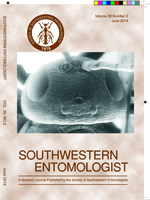The potato psyllid, Bactericera cockerelli (Sulc.) is one of the most economically important insect pests affecting solanaceous crops. Current research on entomopathogenic fungi for control of the pest has shown potential as biological insecticides. We evaluated four Mexican entomopathogenic fungus isolates (three B. bassiana s.l. and one M. anisopliae s.l.) and one commercial isolate (GHA) for control of the potato psyllid. All isolates at a single concentration of 1×108 conidia ml-1 were evaluated under laboratory conditions and were observed to kill more than 80% of psyllids. In addition, one Mexican isolate (Bb42) and the GHA B. bassiana strain were evaluated on ‘ancho’ pepper, Capsicum annuum L., under field conditions. Results showed that control of potato psyllid by Bb42 applied at 1 ×1013 conidia ha-1 was comparable with that by the GHA strain at 2 × 1013 and 4 × 1013 conidia ha-1. Field experiments resulted in significant (P < 0.001) differences in mortality (69.5%) of B. cockerelli by GHA at the highest concentration versus other treatments 7 days after fungal application (mortalities of 22.3 and 21.0% by GHA and BB42, respectively). Thirteen days after application, mortality caused by the lowest concentration of GHA was higher (87.3%) than that of BB42 (64.8%), but similar to the highest concentration of GHA (77.3%). These preliminary results confirmed the potential of selected entomopathogenic fungal isolates, commercial products included, to control potato psyllid on field peppers.
How to translate text using browser tools
1 June 2014
Efficacy of Entomopathogenic Fungi (Hypocreales) for Bactericera cockerelli (Sulc.) (Hemiptera: Triozidae) Control in the Laboratory and Field
F. Tamayo-Mejía,
P. Tamez-Guerra,
A. W. Guzmán-Franco,
R. Gomez-Flores,
L. R. Cruz-Cota
ACCESS THE FULL ARTICLE

Southwestern Entomologist
Vol. 39 • No. 2
June 2014
Vol. 39 • No. 2
June 2014




